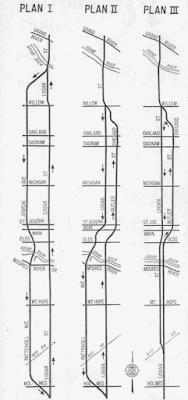Lansing's Martin Luther King Jr Blvd has been the subject of much discussion recently, with the City's planned one-way to two-way conversion of downtown. In order to convert the downtown streets to two-way streets, MLK will need to be reconfigured. As part of the reconfiguration, a proposal includes changing MLK from a 6- and 7-lane road with a median, to a 4- and 5-lane road with medians along about half of its length.
The city sent a public notice to nearby neighbors with some description of what this could look like. Here is Lansingography's adaptation based on the diagrams and text in the letter (text below):
Option 1: 6 Lane Roadway with Modifications
Maintain the existing roadway, which consists of 6 travel lanes, median crossovers and left and right turn lanes.
Modifications needed to accommodate two-way traffic at Ottawa Street and Allegan Street would be:
1. Construct a southbound left turn lane at Ottawa Street.
2. Increase the size of the curb radii at the corners of northbound Martin Luther King Jr. Boulevard at Ottawa Street and Allegan Street to accommodate right turns. With this configuration, westbound Allegan Street traffic would need to use the crossover at Michigan Avenue to turn left onto southbound Martin Luther King Jr. Boulevard.
This design accommodates current (2024) traffic volumes.
Option 2: 5 Lane Roadway with Medians and Pathway
Reconfigure the roadway to two lanes in each direction with a center turn lane and medians. Modifications needed to accommodate two-way traffic at Ottawa Street and Allegan Street would be:
1. Move the east curb line of the southbound roadway to the east between Kalamazoo and Ionia Streets to accommodate two lanes in each direction with a center turn lane.
2. Modify median between Ionia and Ottawa.
3. Add medians between Michigan Avenue and Ottawa Street and between Chelsea Avenue and south of Kinsley [sic] Court.
4. Add a push button activated flashing beacon for Michigan Avenue pedestrian crossing.
This configuration would enable direct turns at Kalamazoo, Allegan and Ottawa Streets and would result in the addition of 1 1⁄2 acres of green space on the east side of the roadway. A 10-foot wide pathway would also be constructed on the east side of the roadway.
This design would accommodate current (2024) traffic volumes and increased volumes resulting from a return to in person employment in downtown to pre-pandemic levels plus additional growth.
The city is still collecting feedback on these designs at the MLK website (look for "Electronic Comment Form").












